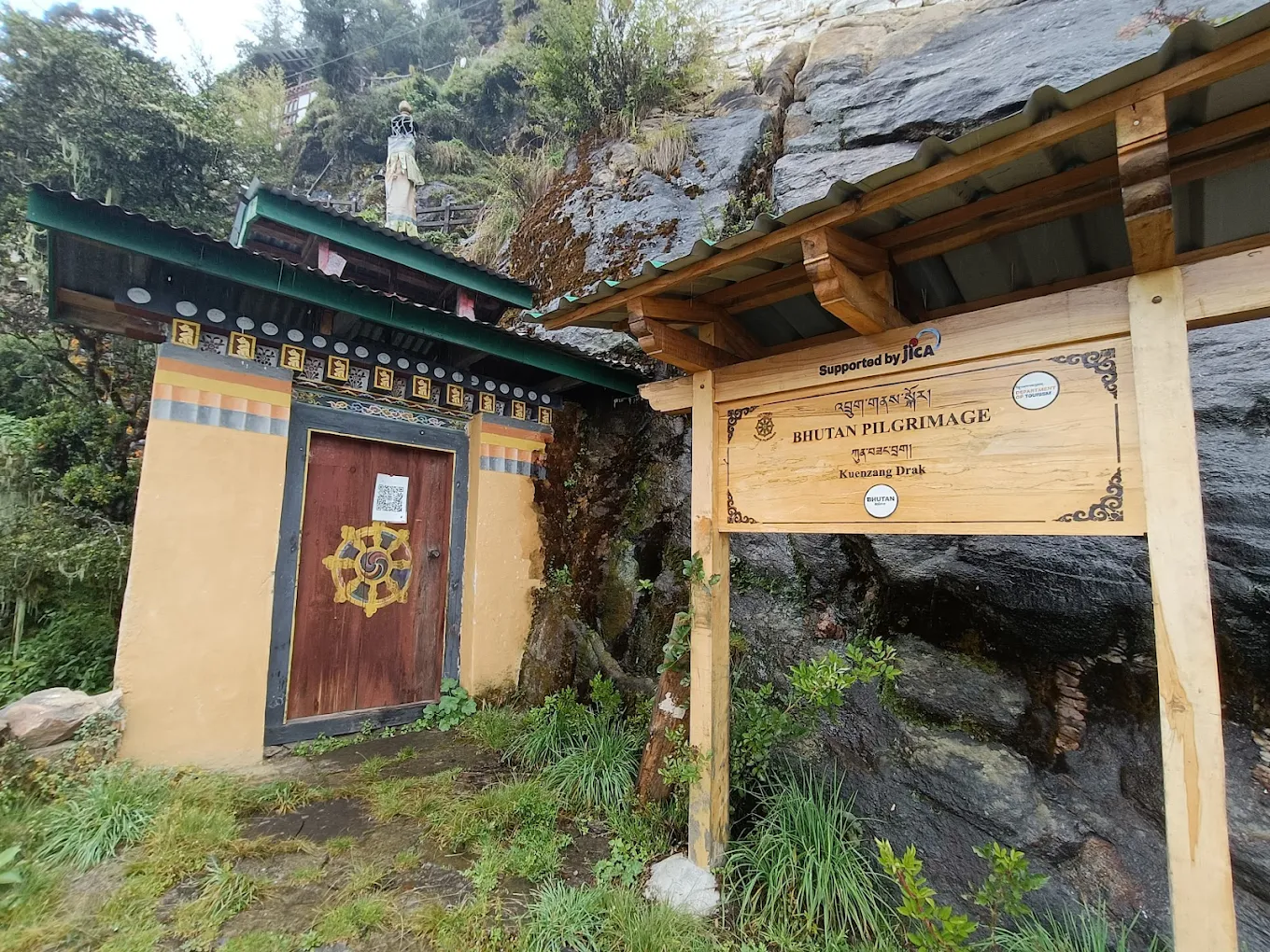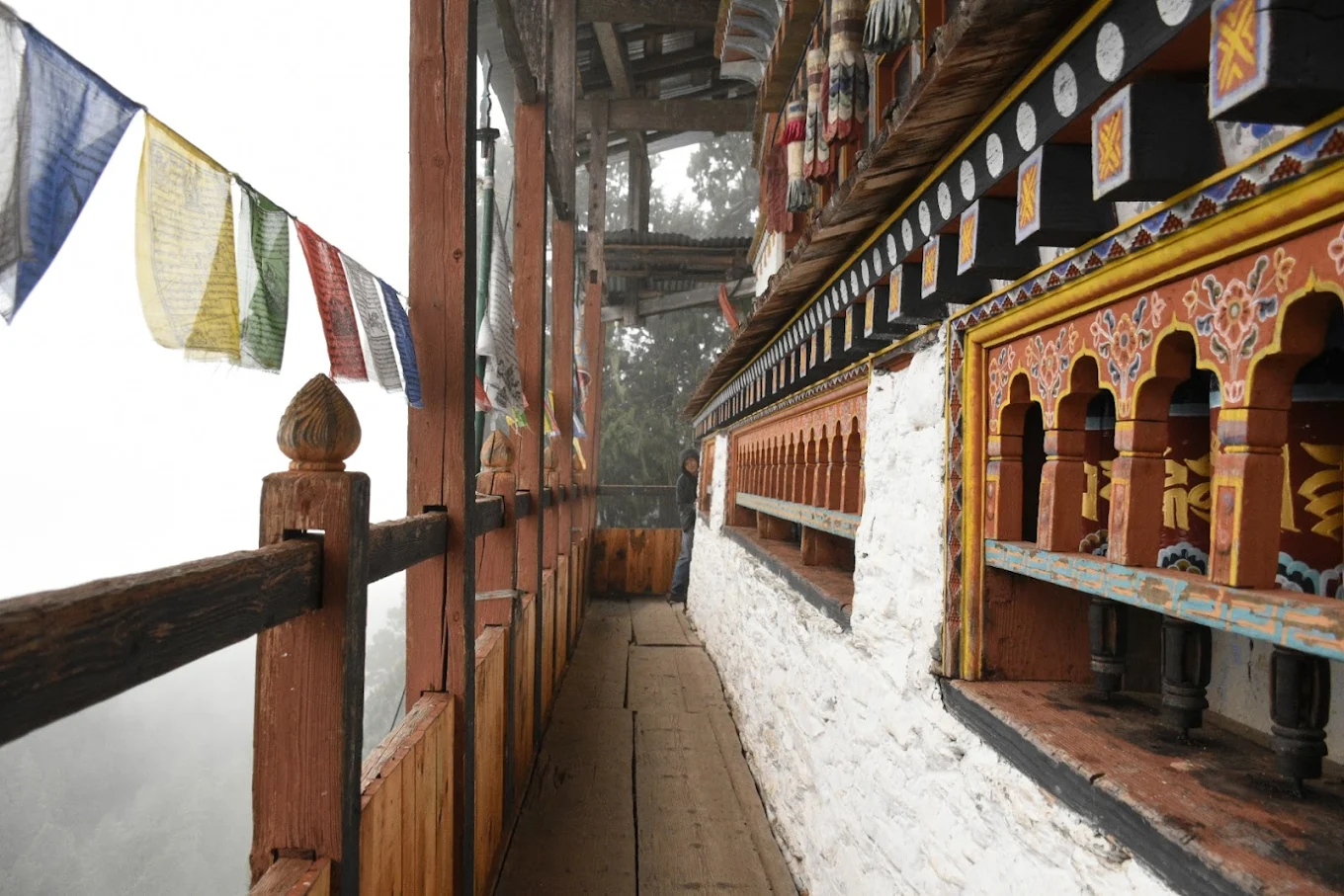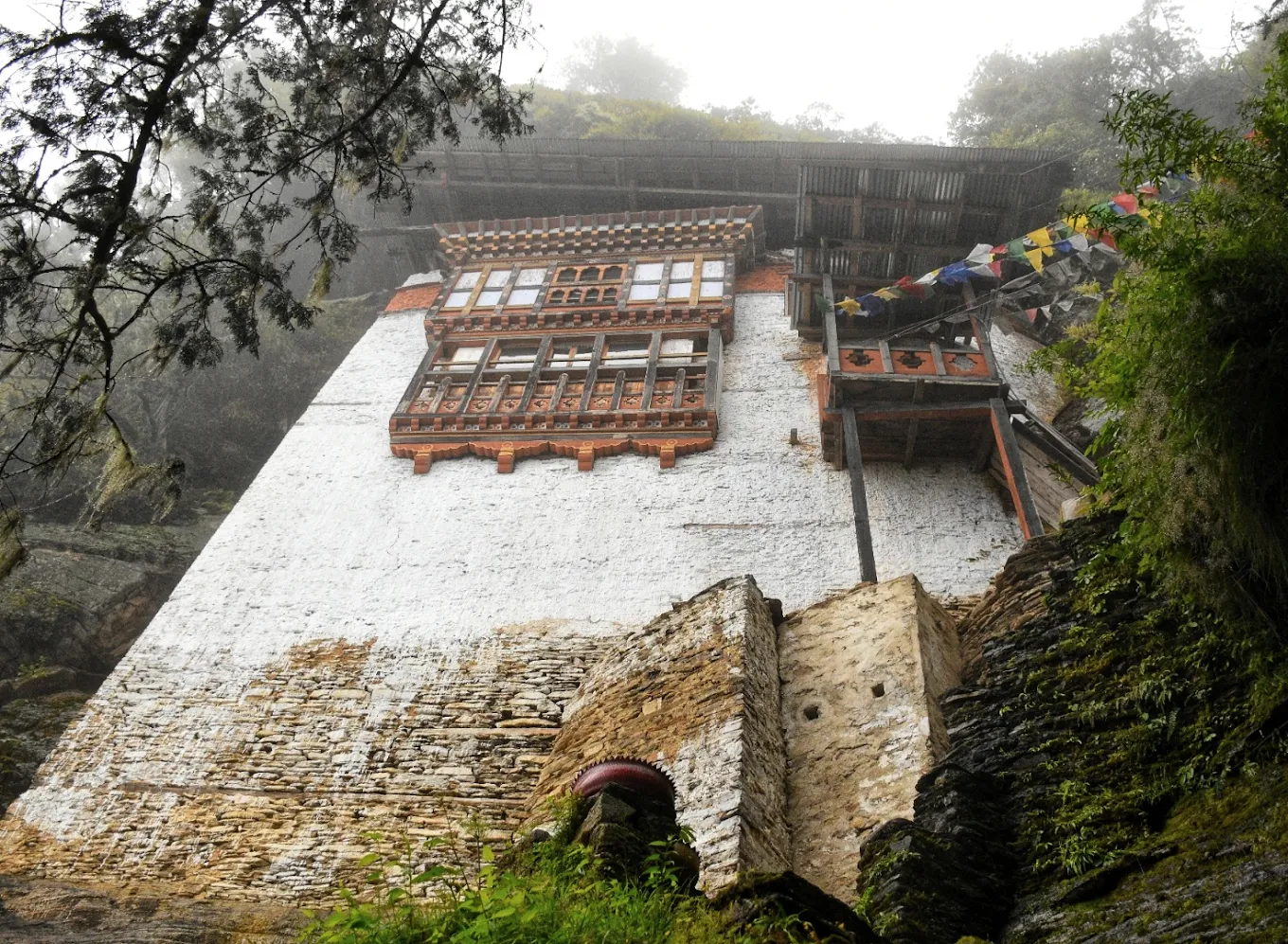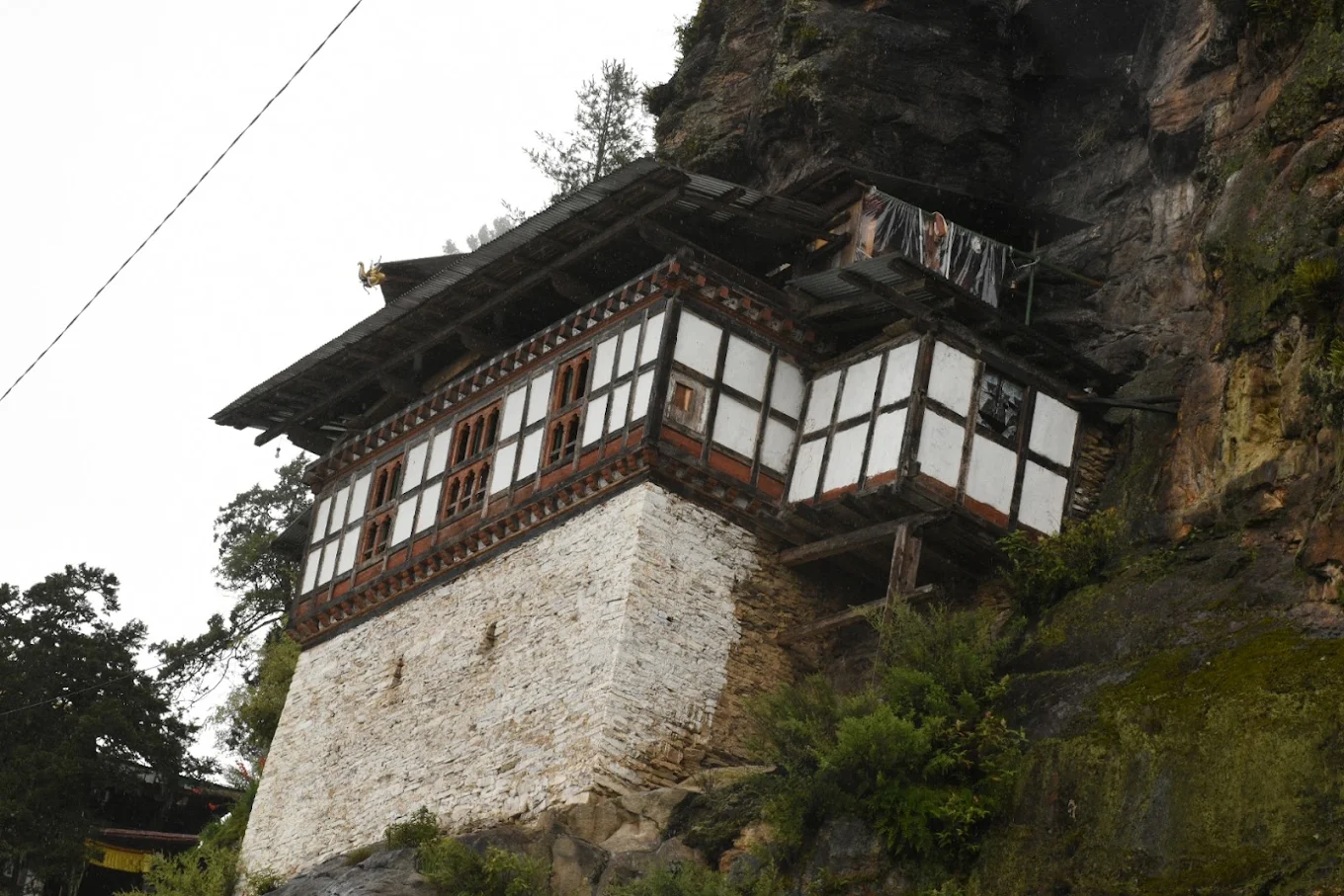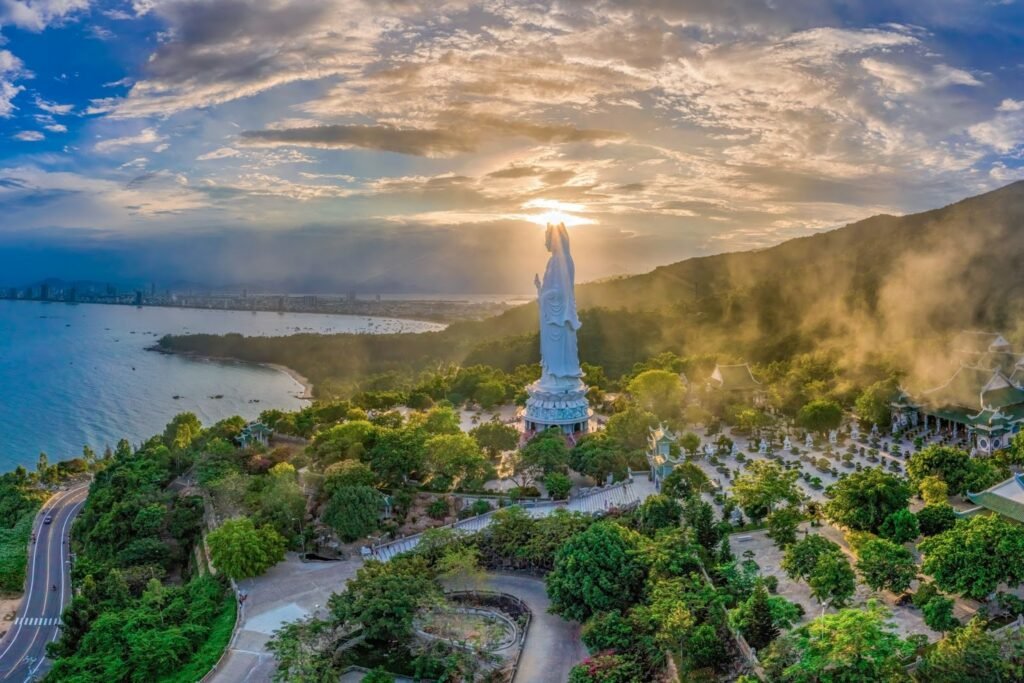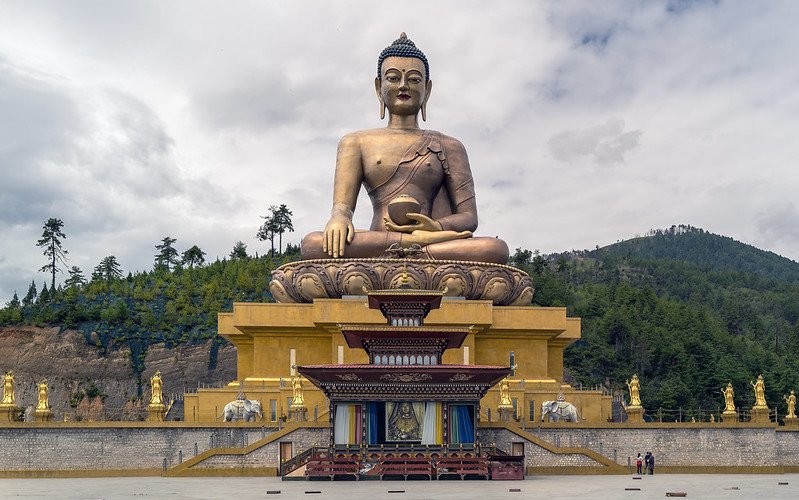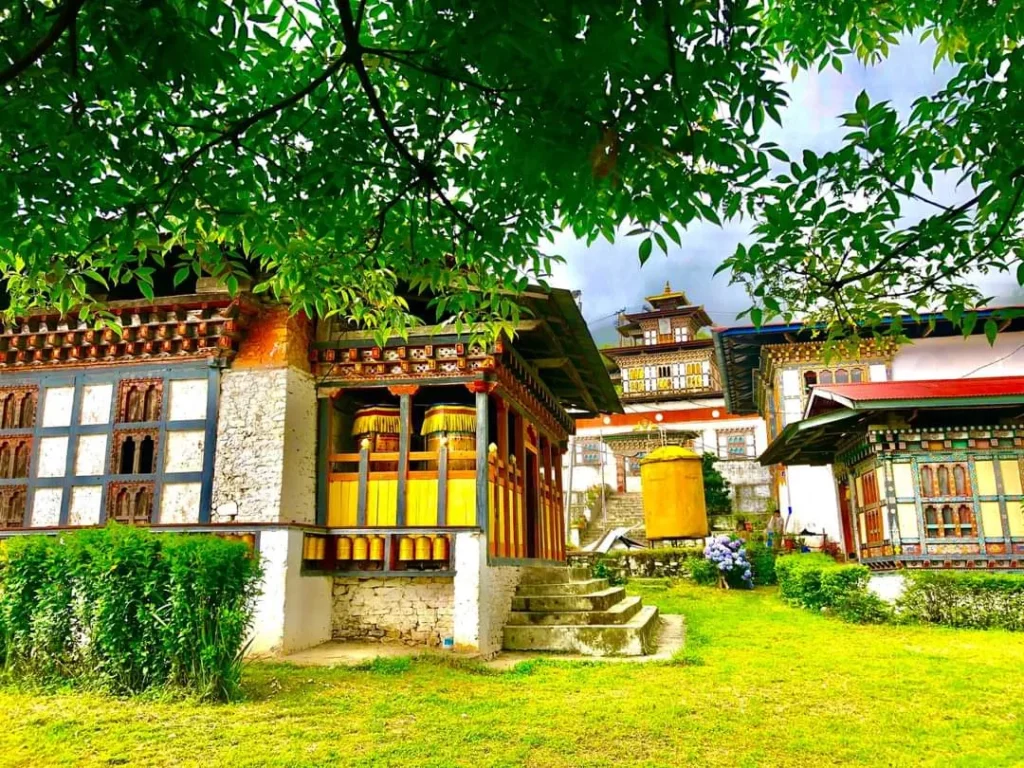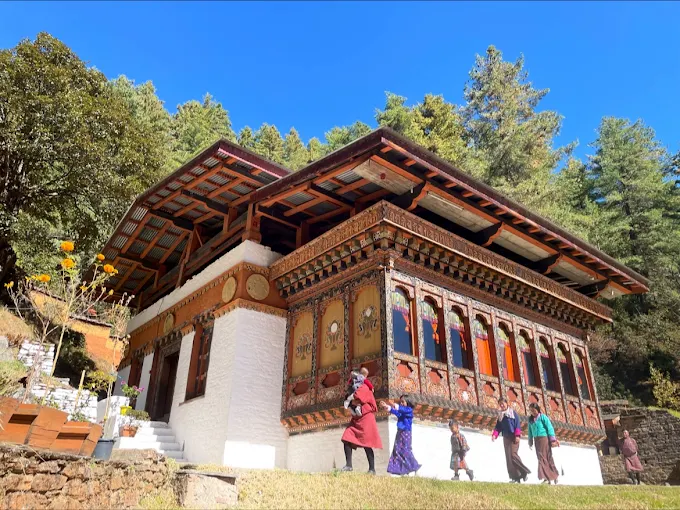Kunzangdrak Monastery: The Sacred Cliff of Tang’s Nyingma Heritage
Perched dramatically on a cliffside overlooking the misty Tang Valley, where the morning light filters through a landscape of pine and rugged slopes, Kunzangdrak Monastery stands as a serene sanctuary, its stone walls catching the dawn’s gentle glow. Within the sacred main temple (lhakhang), monks chant the Om Mani Padme Hum mantra, their voices echoing around a statue of Avalokiteshvara with a thousand eyes and hands, a testament to Nyingma devotion. Established in 1488 by Pema Lingpa, this Nyingma site is revered for its association with Guru Rinpoche’s 8th-century meditation and the treasure revealer’s legacy. The air carries the scent of juniper incense, lit during prayer sessions, while prayer flags flutter against the breeze, blessing the valley below. From its elevated perch in Bumthang Dzongkhag, the sweeping vista of Tang unfolds, connecting the monastery to Bhutan’s spiritual heart. This sacred retreat invites travelers, seekers, and scholars to ascend its trails and immerse themselves in the profound wisdom of Nyingma faith.
Whispers of the Cliff: Overview and Significance
Introduction to Kunzangdrak Monastery
Kunzangdrak Monastery, situated on a cliffside in Bumthang Dzongkhag, Bhutan, at an elevation of 3,350 meters, stands as a revered Nyingma sanctuary, celebrated for its historical role as a meditation site and its connection to Pema Lingpa. A half-hour hike from the road end near Chamkhar Town reveals a tranquil retreat where the rustle of pine forests and valley silence create a peaceful ambiance. Established in 1488 by Pema Lingpa, it embodies Bhutan’s Nyingma heritage, blending meditation with the legacy of its founder. A cultural and spiritual gem, the monastery weaves history, revelation, and Himalayan reverence into a timeless refuge.
Historical Journey
Kunzangdrak Monastery’s history traces back to the late 8th century, when Guru Rinpoche and his disciple Namkhai Nyingpo meditated in the cliffside cave, one of four sacred cliffs in Bumthang. The current temple was founded in 1488 by Pema Lingpa, a treasure revealer who built it as one of his residences after discovering termas in the area. The site includes Pema Lingpa’s living quarters and three temples: Wangkhang (with Avalokiteshvara), Özerphug (meditation cave of his son Thuksey Dawa Gyeltsen), and Khandroma Lhakhang (with a gilded copper statue of Pema Lingpa). Community efforts have preserved its sanctity, maintaining its role as a pilgrimage site.
Cultural Significance
- Nyingma Devotion: Rooted in the Nyingma school, the monastery venerates Guru Rinpoche, Pema Lingpa, and Avalokiteshvara, emphasizing meditation and terma revelation.
- Bhutanese Heritage: A spiritual anchor, it preserves rituals like mantra recitation and pilgrimage, reflecting national identity.
- Pilgrimage Legacy: Its cave and statues enhance its role as a sacred site.
- Regional Influence: Pilgrimages draw devotees from Bumthang and central Bhutan, fostering community ties.
Unique Legacy
- Cliffside Perch: At 3,350 meters, its view of Tang Valley distinguishes it among Bhutan’s monasteries.
- Guru’s Meditation: The 8th-century cave holds sacred potency, a verified historical site.
- Pema’s Legacy: The 1488 founding by Pema Lingpa reflects Bhutanese resilience.
- Cultural Symbol: Its terma tradition mirrors Bhutan’s spiritual depth.
Community and Global Impact
- Local Devotion: The monastery hosts prayers and pilgrimages, strengthening Bumthang’s Nyingma ties.
- Pilgrimage Hub: Visitors are drawn by the cave and Pema Lingpa’s legacy.
- Global Appeal: International meditators seek its spiritual and historical allure.
- Cultural Dialogue: Shared rituals unite Bhutanese and global visitors.
Modern Relevance
- Spiritual Retreat: Kunzangdrak offers a haven for mindfulness in its cliff seclusion.
- Cultural Preservation: It safeguards Nyingma practices, ensuring Bhutan’s heritage endures.
- Pilgrimage Influence: The cave attracts global spiritual seekers.
Historical Anecdotes
- Guru’s Meditation: His 8th-century presence sanctified the cliff.
- Pema’s Discovery: The 1488 terma find marked its founding.
- Family Legacy: His son’s cave adds to its mystique.
Social Role
- Community Hub: Prayers unite Bumthang’s Buddhists.
- Pilgrimage Center: Monks guide devotees in cave rituals.
- Charitable Spirit: Communal support reflects Nyingma compassion.
Artistic Influence
- Thangka Art: Murals of Avalokiteshvara inspire Bhutanese artists.
- Cultural Icon: The Tang view graces local imagery.
- Festival Art: Prayer flags showcase Bhutanese craftsmanship.
Kunzangdrak Monastery’s cliffside aerie, where Guru Rinpoche once meditated, weaves a narrative of devotion and revelation that defines Bhutan’s Nyingma heritage. From its 8th-century sanctity to its role as a pilgrimage site, the monastery’s history resonates with the tranquility of Tang Valley, uniting monks and pilgrims. Its sacred halls and scenic trails set the stage for an architectural tapestry that mirrors its Himalayan soul. As we delve into its physical and spiritual features, Kunzangdrak’s design reveals how its elevated beauty nurtures profound faith and spiritual discovery.
Crafted by the Cliff: Architectural and Spiritual Features
Iconic Design
Kunzangdrak Monastery’s architecture blends Nyingma austerity with its cliffside setting, creating a sanctuary that harmonizes with Tang’s rugged landscape. Stone walls and wooden roofs, adorned with prayer flags, rise from the 3,350-meter elevation, reflecting Buddhist simplicity. The compact layout, centered on the main lhakhang, prioritizes meditative function, with courtyards fostering pilgrimage. Its perch above Tang Valley enhances its sacred resonance, tying the monastery to Bhutan’s Himalayan ethos.
Key Structures
- Main Lhakhang (Wangkhang): The spiritual core, housing Avalokiteshvara, built in 1488.
- Özerphug: The meditation cave of Thuksey Dawa Gyeltsen, a sacred site.
- Khandroma Lhakhang: Contains a gilded copper statue of Pema Lingpa.
- Chorten Courtyard: A small area with prayer wheels, marking the cliff base.
Worshipped Statues
- Avalokiteshvara: A bronze statue with a thousand eyes and hands, symbolizing compassion.
- Pema Lingpa: A gilded copper statue, representing treasure revelation.
- Spiritual Role: Monks offer butter lamps to Avalokiteshvara, seeking mercy.
Materials and Techniques
- Construction: Local stone and timber, joined with traditional methods, ensure durability.
- Artistry: Murals and carvings, crafted by early artisans, reflect Nyingma style.
- Cultural Essence: The design prioritizes meditative retreat, distinct from dzongs.
Signature Elements
- Cliffside Cave: Özerphug anchors the spiritual narrative.
- Valley View: The 3,350-meter perch offers a serene setting.
- Prayer Flags: Fluttering flags carry blessings across the valley.
Preservation Efforts
- Maintenance: Community efforts preserve the lhakhang and cave.
- Challenges: Cliff erosion affects stonework, requiring care.
- Modern Additions: Solar lights enhance evening accessibility.
Environmental Integration
- Cliff Harmony: The monastery’s design respects Tang’s ecosystem.
- Eco-Practices: Monks maintain trails and protect flora.
- Wildlife Haven: Birds nest nearby, enhancing serenity.
Landscape Integration
- Cliff Perch: Enhances meditative focus with valley views.
- Tang Vista: The valley mirrors inner peace.
Kunzangdrak Monastery’s stone lhakhang and sacred cave, overlooking Tang Valley, are sanctuaries for the Nyingma practices that define its spiritual soul. The statue of Avalokiteshvara, illuminated by butter lamps, anchors rituals that connect monks to Bhutan’s spiritual lineage. These hallowed spaces, alive with chants and pilgrimage, invite visitors to engage with the monastery’s living traditions. As we explore its rituals, Kunzangdrak’s role as a meditative retreat comes to life, guiding devotees toward compassion and revelation.
Rites of the Cave: Rituals and Practices
Daily Sacred Rites
- Morning Chanting: Monks recite the Om Mani Padme Hum mantra at dawn, fostering compassion.
- Meditation Sessions: Silent meditation, held twice daily, centers on Dzogchen practices.
- Butter Lamp Offerings: Devotees light lamps before Avalokiteshvara, praying for mercy.
Unique Practices
- Cave Meditation: Monks meditate in Özerphug, honoring Pema Lingpa’s legacy.
- Terma Rituals: Ceremonies celebrate Pema’s revelations, a Nyingma tradition.
- Signature Ritual: Offering khata scarves during cave visits, tied to pilgrimage.
Festival Traditions
- Tang Tshechu (dates vary): A local festival with prayers and circumambulation.
- Lhabab Duchen: Ceremonies honor the Buddha’s descent, with chorten circuits.
- Statue Veneration: Avalokiteshvara’s statue is adorned with silk during festivals.
Visitor Engagement
- Accessible Rituals: Visitors can join chants or visit the cave, guided by monks.
- Offerings: Butter lamps and prayer flags, available at the monastery, invite participation.
- Nyingma Etiquette: Bow before statues and maintain silence during meditation.
Spiritual Community Roles
- Monastics: Around 10–20 monks maintain the site and lead rituals.
- Lamas: Senior monks guide cave meditations and pujas.
- Lay Devotees: Bumthang villagers maintain trails and support events.
Ritual Symbolism
- Butter Lamps: Represent wisdom illuminating revelation.
- Khata Offerings: Symbolize purity and devotion.
- Cave Imprint: Signifies Guru Rinpoche’s presence.
Monastic Life
- Daily Routine: Monks rise at 5:00 AM for chants, meditation, and maintenance.
- Community Service: Monks guide pilgrims and protect the site.
- Training Hub: Monks learn Nyingma practices, supporting Bumthang’s faith.
Kunzangdrak Monastery’s rituals, from the Om Mani Padme Hum mantra to cave meditations, breathe life into its cliffside sanctuary, connecting devotees to the Nyingma lineage. The monastery’s spiritual practices, rooted in Bhutan’s pilgrimage faith, invite visitors to engage with its sacred heart, whether through chants or cave visits. For travelers, these rites offer a glimpse into Tang’s sacred traditions, accessible within its rugged grounds. As we turn to visitor information, Kunzangdrak’s cliffside setting guides practical planning, ensuring a meaningful journey to this spiritual retreat.
Journey to the Cliff: Visitor Information
Navigating to Kunzangdrak Monastery
- Location: Bumthang Dzongkhag, 3,350 meters, accessible via a trail from Chamkhar Town.
- Landmarks: Near the Tang Valley road end, with Dzongkha and English signs.
- Routes: Hike from the road end (30 minutes) or drive to the base.
Address of Kunzangdrak Monastery
- Dzongkha: Kunzangdrak Goenpa, Bumthang Dzongkhag, Bhutan.
- English: Kunzangdrak Monastery, Bumthang District, Bhutan.
Visiting Hours and Etiquette
- Hours: Open daily, 6:00 AM–5:00 PM, with ceremonies varying by schedule.
- Etiquette: Dress modestly, remove shoes before lhakhang, and avoid disturbing rituals.
- Nyingma Custom: Offer butter lamps with both hands and bow to statues.
Transport Options
- By Foot: Hike from the road end (30 minutes, moderate difficulty).
- By Vehicle: Drive to the trailhead, then walk.
- By Horse: Local guides may offer horses, arranged at the base.
Accessibility and Safety
- Mobility: Steep trails may challenge those with mobility issues; no ramps available.
- Safety: Stable paths with guideposts; carry water for the climb.
- Tips: Wear sturdy hiking boots and bring a packed lunch.
Amenities and Surroundings
- Facilities: Basic restrooms near the monastery; no shops on-site.
- Nearby: Tang Rimochen Lhakhang and Jambay Lhakhang, within 15–20 km, offer cultural experiences.
- Dining: Picnic areas encourage packed meals, with options in Chamkhar.
Immersive Visitor Tips
- Best Timing: Early morning hikes offer clear views and monk chants.
- Sensory Moments: Inhale pine-scented air and hear valley silence.
- Statue Connection: Offer butter lamps to Avalokiteshvara and reflect briefly.
- Pilgrimage Planning: Visit the cave for spiritual connection.
Photography Tips
- Best Angles: Capture the lhakhang at sunrise for soft light.
- Respectful Shots: Avoid photographing rituals without permission.
- Scenic Views: The Tang Valley offers serene landscapes.
- Equipment: A lightweight camera suits the trek.
The journey to Kunzangdrak Monastery, guided by Tang’s cliffside trails, is a pilgrimage that blends spiritual discovery with sacred retreat, inviting visitors to engage with its Nyingma traditions. The monastery’s lhakhang and cave, vibrant with chants and reverence, offer a window into Bhutan’s sacred heart, where wisdom feels tangible. Beyond its cliffside beauty, Kunzangdrak’s deeper cultural and spiritual significance enriches the experience, revealing the essence of Himalayan Buddhism. As we explore these insights, the monastery’s role as a beacon of faith and revelation comes into sharper focus, deepening our connection to its sacred legacy.
Insights of the Cliff: Cultural and Spiritual Reflections
Nyingma Philosophy
Kunzangdrak Monastery embodies Nyingma’s core: compassion and wisdom through Dzogchen meditation and terma revelation. Guru Rinpoche, Pema Lingpa, and Avalokiteshvara inspire devotees, reflected in chants and cave rituals. Mahamudra teachings emphasize direct realization, guiding monks toward enlightenment.
Environmental Spirituality
The monastery’s cliff perch ties it to Himalayan reverence for nature. Tang’s pine forests and valley views foster meditative calm, with offerings honoring local spirits. The landscape invites reflection on harmony with the natural world.
Artistic Symbolism
Murals depict Avalokiteshvara’s compassion, symbolizing mercy. The cave imprint represents Guru’s presence, while prayer flags balance elements. These elements weave Nyingma ideals into the monastery’s aesthetic.
Community Resilience
Founded by Pema Lingpa’s followers, Kunzangdrak reflects Bhutanese perseverance through time. Its preservation showcases collective faith, sustained by community efforts.
Environmental Stewardship
The monastery’s slopes foster Buddhist eco-ethics. Monks protect trails and flora, urging visitors to honor the cliff’s sanctity.
Meditative Practices
Nyingma meditation, including Dzogchen, cultivates awareness. The cave offers spaces for retreat, guided by monks, amplifying inner peace.
Cultural Narratives
- Guru’s Legacy: His 8th-century meditation inspires devotion.
- Pema’s Revelation: The 1488 terma find links past and present.
- Pilgrimage Lore: Cave visits carry Nyingma traditions.
Historical Context
- Nyingma Roots: Guru Rinpoche’s 8th-century visit shaped its identity.
- Pema’s Era: The 1488 founding strengthened its role.
- Community Continuity: Preservation ensures its legacy.
Reflecting on the Journey
Kunzangdrak Monastery, cradled on Tang’s sacred cliff, is a sanctuary where wisdom meets revelation. Its lhakhang and cave, alive with Avalokiteshvara’s legacy, embody Bhutan’s Nyingma soul, inviting all to seek enlightenment. The monastery’s trails, worn by centuries of pilgrims, tell a story of devotion, rooted in Himalayan faith. Whether meditating before Pema Lingpa’s statue, exploring the cave, or tracing Bhutan’s terma heritage, visitors find a space to reflect and connect. As you descend, the pine scent and prayer flags’ flutter linger, a reminder that peace is always within reach.
